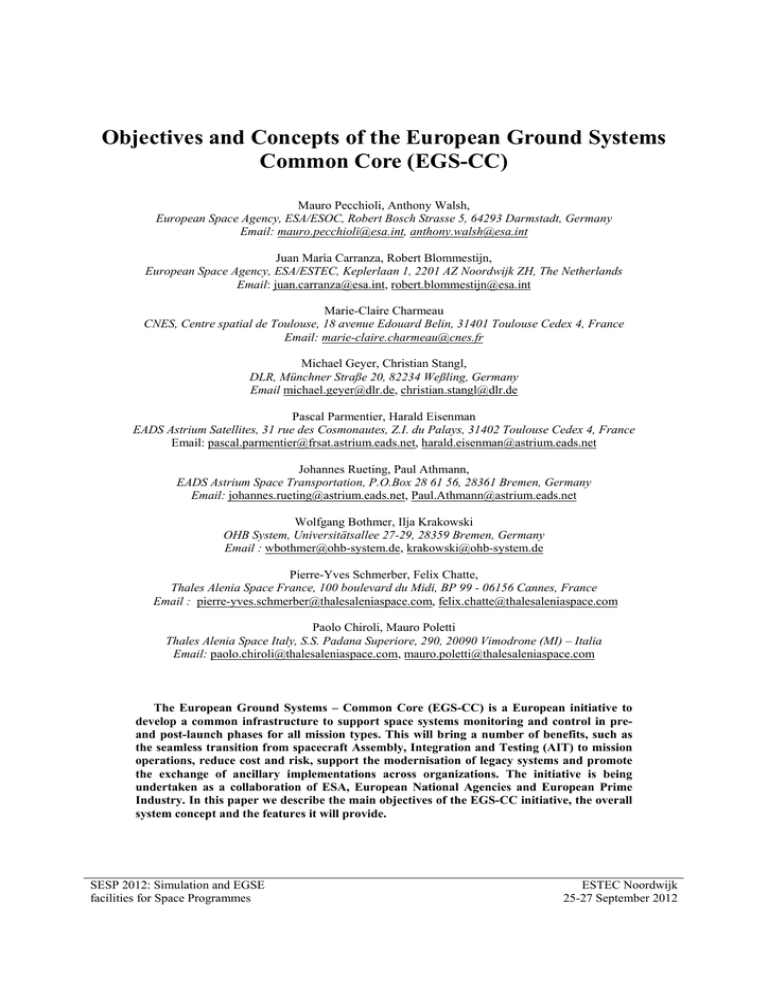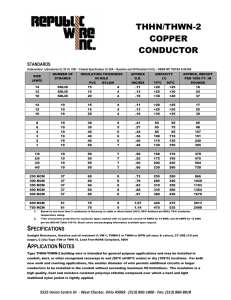Objectives and Concepts of the European Ground Systems
advertisement

Objectives and Concepts of the European Ground Systems Common Core (EGS-CC) Mauro Pecchioli, Anthony Walsh, European Space Agency, ESA/ESOC, Robert Bosch Strasse 5, 64293 Darmstadt, Germany Email: mauro.pecchioli@esa.int, anthony.walsh@esa.int Juan María Carranza, Robert Blommestijn, European Space Agency, ESA/ESTEC, Keplerlaan 1, 2201 AZ Noordwijk ZH, The Netherlands Email: juan.carranza@esa.int, robert.blommestijn@esa.int Marie-Claire Charmeau CNES, Centre spatial de Toulouse, 18 avenue Edouard Belin, 31401 Toulouse Cedex 4, France Email: marie-claire.charmeau@cnes.fr Michael Geyer, Christian Stangl, DLR, Münchner Straße 20, 82234 Weßling, Germany Email michael.geyer@dlr.de, christian.stangl@dlr.de Pascal Parmentier, Harald Eisenman EADS Astrium Satellites, 31 rue des Cosmonautes, Z.I. du Palays, 31402 Toulouse Cedex 4, France Email: pascal.parmentier@frsat.astrium.eads.net, harald.eisenman@astrium.eads.net Johannes Rueting, Paul Athmann, EADS Astrium Space Transportation, P.O.Box 28 61 56, 28361 Bremen, Germany Email: johannes.rueting@astrium.eads.net, Paul.Athmann@astrium.eads.net Wolfgang Bothmer, Ilja Krakowski OHB System, Universitätsallee 27-29, 28359 Bremen, Germany Email : wbothmer@ohb-system.de, krakowski@ohb-system.de Pierre-Yves Schmerber, Felix Chatte, Thales Alenia Space France, 100 boulevard du Midi, BP 99 - 06156 Cannes, France Email : pierre-yves.schmerber@thalesaleniaspace.com, felix.chatte@thalesaleniaspace.com Paolo Chiroli, Mauro Poletti Thales Alenia Space Italy, S.S. Padana Superiore, 290, 20090 Vimodrone (MI) – Italia Email: paolo.chiroli@thalesaleniaspace.com, mauro.poletti@thalesaleniaspace.com The European Ground Systems – Common Core (EGS-CC) is a European initiative to develop a common infrastructure to support space systems monitoring and control in preand post-launch phases for all mission types. This will bring a number of benefits, such as the seamless transition from spacecraft Assembly, Integration and Testing (AIT) to mission operations, reduce cost and risk, support the modernisation of legacy systems and promote the exchange of ancillary implementations across organizations. The initiative is being undertaken as a collaboration of ESA, European National Agencies and European Prime Industry. In this paper we describe the main objectives of the EGS-CC initiative, the overall system concept and the features it will provide. SESP 2012: Simulation and EGSE facilities for Space Programmes ESTEC Noordwijk 25-27 September 2012 I. Introduction A. Background Within Europe there are many different systems for monitoring and control used by companies/agencies for space system operations and Assembly Integration and Testing (AIT). Some of these systems are common to both operations and AIT, while some are specific. Often multiple systems are used in AIT of a space system by different companies or at different levels (e.g. payload/system) or in different phases. Many of these existing systems have reached or are reaching their end of life. The systems are often using old software technologies and hardware platforms that are difficult to modernise. The maintenance and evolution costs are therefore becoming excessively complex with time. The compatibility/exchange of information with other systems is also often difficult leading to little synergy across missions and project phases Given the difficulties mentioned above, during 2009-2010, the European Space Agency (ESA) discussed with large European System Integrators, including Astrium Satellites, Astrium Space Transportation, Thales Alenia Space (France and Italy) and OHB System, the possibility of a collaboration to develop a European Ground Systems Common Core (EGS-CC) which would provide a common infrastructure to support space systems monitoring and control in pre- and post-launch phases. The French and German national space agencies, CNES and DLR also signalled their desire to join the initiative and a Memorandum of Understanding was finalised in support of the EGSCC initiative. B. Objectives The objective of the European Ground Systems – Common Core (EGS-CC) is to develop a common infrastructure to support space systems monitoring and control in pre- and post-launch phases for all mission types. This is expected to bring a number of benefits, including: The seamless transition from spacecraft Assembly, Integration and Testing (AIT) to mission operations, thus maximising synergy across all mission phases Enable overall cost reductions by sharing development, sustaining and maintenance of a single infrastructure across organisations Facilitate cost and risk reduction when implementing space projects through the provision of a stable common infrastructure which can be easily tailored for the needs of a specific mission and/or organisation Enable the modernization of legacy EGSE and MCS systems Enable the exchange of ancillary implementations across organizations The objectives of the EGS-CC are therefore very ambitious and the main system features include: Support of all mission types and phases Open, component based, service oriented architecture Generic and extensible functionality Binary compatibility Layered implementation Clear separation between generic M&C functions (kernel) and specific features of the controlled system (adaptation layer) Configurable level of operations abstraction Standardised interfaces (as far as possible…) Technology isolation (as far as possible…) Long term maintainability High performance and scalability SESP 2012: Simulation and EGSE facilities for Space Programmes ESTEC Noordwijk 25-27 September 2012 II. System Concepts This section provides a brief introduction to a few of the many system concepts which have been defined in order to characterise the functional scope of the system and provide a clear context for the understanding of the applicable requirements. A. Monitoring and Control Model The Monitoring and Control Model (MCM) provides the functional core of the EGS-CC kernel. It includes the capability to model the complete space system from a monitoring and control perspective. It encapsulates the main monitoring and control functions (e.g. parameter processor, activities handler, events processor) and provides access to all data of Monitoring and Control (M&C) relevance, thus acting as an abstraction layer for M&C operations. It is based on the principles of the M&C view of the Space System Model (SSM) defined within the ECSS E-ST-70-31C Ground Systems and Operations – Monitoring and Control Data Definition [4]. Information is organised in a structured way which reflects the functional decomposition of the space system, including the controlled system as well as the control system itself and covering both the Space Segment (e.g. a satellite or launcher) and Ground Segment (i.e. the overall infrastructure required during Development, Assembly, Integration and Testing and for Operations) for the AIT or operational contexts. The decomposition of a typical space system as depicted by the MCM is illustrated in the Figure 1. OBDH Gyro2 Spacecraft Space Segment AOCS Gyro1 MCM Product Ground Support Equipment Ground Segment Legend M&C System System Element Reporting Data Activity Event Figure 1. Monitoring and Control Model The Figure 1 shows how the space system is represented in the MCM as a hierarchy of System Elements (SE). The system element is a data structure whose properties provide the means to organise the space system knowledge in a hierarchical structure. From the highest level downwards, this is typically: system, subsystem, set, equipment or software product, assembly, part (hardware) or module (software), but it is not required to be a one-to-one mapping of the physical decomposition of the space system. The space system monitoring and control knowledge is categorised into activities, events and reporting data, according to the following definitions: Activity – An activity is a space system monitoring and control function supported by the EGSE or Mission Control System (MCS). An activity can be executed within the EGS-CC based system (e.g. a procedure, a script, a call to a system function) or implemented as a command either to the space segment or any other command type that is specific to a given implementation of the space system (e.g. a command to a Special Check-Out Equipment (SCOE) or to a ground station using a proprietary protocol). Event – An event is an occurrence of a condition or group of conditions of operational significance. Events are widely used within the space system to trigger the execution of functions (e.g. acquisition of signal can initiate telemetry processing tasks at the ground station). SESP 2012: Simulation and EGSE facilities for Space Programmes ESTEC Noordwijk 25-27 September 2012 Reporting Data – Reporting data is information that a system element provides, irrespective of how this information is used. Reporting data can comprise measurements which reflect the state of the associated system element or an output product whose purpose is to be used by another system element (e.g. manoeuvre parameters provided by a flight dynamics system). Although the MCM organises reporting data, activities and events into a more logical structure, the view presented to the end user can be customised as required. For example, it is still possible for the end user to view and interact with the system as a more traditional flat list of parameters and commands if so desired. The MCM concept ensures a clean separation between the M&C abstract view and generic processing and the specific processing related to the data units exchanged with the controlled system. This approach allows the application of the same M&C kernel to different types of controlled systems, such as spacecraft, SCOE equipment, ground station equipment, etc. It means that the M&C system can control not only the target system (e.g. a spacecraft), but also all other contributing ground systems (e.g. EGSE supporting equipment, and the EGS-CC itself), with which the exchanged data are not necessarily based on TM/TC packets. Knowledge about the space system can be “static” or “dynamic” in nature. The MCM static knowledge encompasses all monitoring and control data produced during the development and the maintenance of the space system and is used to tailor an EGS-CC system for a given mission; The dynamic knowledge encompasses all monitoring and control data produced by the space system during testing and operations (e.g. the archive of all sent telecommands and all received telemetry, the output of the ground processing of monitoring data). In EGS-CC, this is referred to as the MCM State. The relationship between the MCM static knowledge and the MCM state is illustrated in the Figure 2. The MCM static knowledge is stored in the M&C database while the dynamically generated MCM state information is stored in a data archive. MCM Static Knowledge ECSS E-ST-70-31C defined by SSM SE, Activities, Events, Reporting Data MCM Statetime Run-time status Of MCM stores M&C Database stores Data Archive Figure 2. MCM Static and Dynamic Knowledge B. Processing Model and Data Archiving The MCM is a model of the complete space system for the purpose of monitoring and control. The main inputs to the MCM therefore is monitoring data received from the controlled system, referred to as source monitoring data. There is also other data generated by the EGS-CC applications inside and outside the kernel which can change the state of the MCM (e.g. requests to initiate activities). Both the raw data received from an external system (e.g. the controlled system) as well as the internally generated source data are stored in a source data archive. The source data SESP 2012: Simulation and EGSE facilities for Space Programmes ESTEC Noordwijk 25-27 September 2012 is fed into an MCM processing model which generates the dynamic state of the MCM which is stored in the processed data archive. This is illustrated in the following Figure 3. Kernel Application Processed Data Archive (MCM State) EGS‐CC Application Source monitoring data MCM Access layer Source Data Archive (internal data) MCM Input Processor MCM State Parameter Processor Event Processor Dynamic M&C Model View raw data Source Data Archive (Raw data) Store live and deferred raw data replay Activity Handler Source monitoring data (replay) Source monitoring data Raw data parameter extraction Legend raw monitoring data live Kernel Reference Implementation Raw Data Receiver Figure 3. Data Processing The processed data archive is populated with data from the MCM processor when raw data is received from the controlled system in live mode or when the raw and internal data stored in the source data archive is re-processed in playback or reprocessing mode. The processed data may be retrieved from the processed data archive at any stage and does not require the (re)processing of data stored in the source data archive in order to be returned to the retrieving application in an engineering meaningful form. C. System Organisation The EGS-CC system organisation is based on the concepts illustrated in the following Figure 4. System 1 * System Instance 1 * System Session User User User Session Session Session Figure 4. System Organization The EGS-CC system comprises of the software source code and binaries for a given EGS-CC based system, applied to a specific application and mission. The system is composed of at-least the EGS-CC Kernel which is independent of a specific mission, specific adaptations and any other additional auxiliary systems. A system instance SESP 2012: Simulation and EGSE facilities for Space Programmes ESTEC Noordwijk 25-27 September 2012 is a particular system release installed on a specific target platform. The running system instance is the set of processes executed at run-time, which belong to a single system instance, which can be managed together in terms of start/stop and status monitoring. The system session is a logical grouping of EGS-CC components belonging to a given running system instance, which use a given tailoring and configuration , dedicated to the processing of the data of a controlled space system and generating a separate set of outputs within the processed data archive. In the context of EGS-CC, tailoring is the process of mission data definition for adapting customised EGS-CC system software (if needed) to a given mission and operations concept, while configuration is the tuning of the configuration parameters for the run-time system (i.e. without the need to recompile the system). There may be different types of system sessions: operational, simulations, tests, administration, analysis. Several system sessions can run in parallel, especially in the space AIT environment, producing independent set of results. Within a specific system session, there may be any number of user sessions which provide the execution of a specific context dedicated to a given user. D. Role of Standards The EGS-CC is intended to support a number of standards which will enable the EGS-CC to interoperate with other systems and other segments. The open nature of the EGS-CC allows support for standards to be added as specific adaptations, but a number of standards will be supported as part of the base implementation, including: Telemetry and telecommand protocols (ECSS-E-ST-50-03 and 04) [1], [2] M&C data definitions (ECSS-E-ST-70-31) [4] Procedures languages (ECSS-E-ST-70-32) [5] although this does not mean that the procedures language supported by EGS-CC must be PLUTO but rather that it shall meet all the capability requirements specified in this standard Packet Utilisation Standard (PUS) (ECSS-E-ST-70-41) [6] for missions implementing those services Standards related to services to be used or offered: MAL (CCSDS 521.0-B) [8], Mission Operation Services Concept (CCSDS 520.0-G-3) [7] and SLE (CCSDS 9xx) [9] On-board control procedures (ECSS-E-ST-70-01) [3] SESP 2012: Simulation and EGSE facilities for Space Programmes ESTEC Noordwijk 25-27 September 2012 III. Conceptual Architecture This section provides a brief introduction to some of the EGS-CC concepts related to its conceptual decomposition and architecture. A. Architectural Layers The EGS-CC architecture is logically structured in separate layers, isolating different responsibilities and defining clear interfaces between them. The following Figure 5 shows the architectural layers of the EGS-CC. Presentation layer External systems layer Implementation Layer Legend Kernel Layer Service layer Reference Implementation Layer Adaptation layer Extension layer Reference Test Facility Layer M&C Kernel Processing layer Application support layer Data layer Component management layer Figure 5. Architectural Layers The lower architectural layers provide cross-cutting features used across all EGS-CC functions and include: Component management, providing the framework in which the EGS-CC components are developed and executed. It is the lowest level platform of the application, in which the application support and processing components are integrated. Application support, providing general purpose components and services (e.g. logging) to ease development effort and ensure harmonisation and consistency of application components usage at run time. Data layer, responsible for the storage, distribution and management of data. The processing layer contains the business logic of the system. It includes all the components which model the processing of the system. It contains the following important sub-layers, according to their functionality: M&C component layer, providing generic M&C components which implement the common M&C functionality for the different applications (e.g. procedure execution, scripting execution, generic processing models, etc,). Adaptation layer, containing the components which implement application and mission specific functionality, to adapt the EGS-CC to different target applications and controlled systems. The adaptation layer includes specific interfaces with external systems, such as SLE transfer with ground stations for spacecraft missions, or applicable protocols to interact with ground station equipment, SCOEs, etc. Extension layer, containing components with additional functionality specific for different applications or missions, which extends the standard monitoring and control functionality provided by the generic and adaptation layers. SESP 2012: Simulation and EGSE facilities for Space Programmes ESTEC Noordwijk 25-27 September 2012 The service layer provides access to the lower layers, encapsulating internal interfaces into well-defined services. It provides the provision of services of EGS-CC components to external consumers (giving access to internally processed data). The presentation layer contains user interface components, which will be mainly dependent on the different applications and missions. They may interact with the processing layer directly, or through the service layer. The external systems layer represents the external systems, or their emulated versions implemented for testing. The EGS-CC functionality is also organised in different layers for its implementation, depending on their purpose and scope and include: Kernel, which contains the generic functionality applicable to all applications and missions, for both general purpose, and monitoring and control functions. It is intended to be reused across all EGS-CC based systems for all applications, missions and purposes and cannot be modified. Reference implementations, containing application specific functionality, intended to be applied in some but not all EGS-CC based systems. This layer is what adapts EGS-CC software to a given application and mission. The reference implementations may be replaced or adapted for the specific needs of a mission or organisation. The EGS-CC will provide specific reference implementations for a selected category of missions and applications (e.g. PUS spacecraft, SLE ground stations). Reference test facilities, providing external functionality needed for testing EGS-CC based systems in isolation. Test facilities are not part of EGS-CC based systems, but implemented for supporting tests. B. Architectural Styles In order to fulfil its objectives, the EGS-CC design follows both a Component Based Architecture (CBA) and Service Orientated Architecture (SOA). This is supported by underlying middleware platforms which comprise: Component Framework, supporting the development of EGS-CC implementation components, their composition into EGS-CC composite components, and their deployment and execution within a component run-time platform. Service Integration Platform, supporting the integration of a complete EGS-CC based system through the provision of an Enterprise Service Bus (ESB). The component framework supports the development and execution of EGS-CC components, the building blocks for a complete EGS-CC based system, while the service integration platform supports the integration of EGSCC components, component composites and external systems to form a complete EGS-CC based system. The service integration platform is able to integrate heterogeneous systems communicating via different protocols, while the component framework offers a harmonised and optimised approach to component implementation based on a specific component model. The following Figure 6 illustrates the run-time context of the component framework and the service integration platform within the EGS-CC architecture. The top level composite shown in the figure comprises of two lower level component composites, containing implementation components. The contained implementation components can be either part of the kernel, reference implementation or reference test facility implementation layers introduced earlier. The example also illustrates the required and provided interfaces of components which can be promoted to the level of the composite in which the component is contained. The composite also defines the connections between the provided and required interfaces of its internal components. SESP 2012: Simulation and EGSE facilities for Space Programmes ESTEC Noordwijk 25-27 September 2012 External System Client App Legend Kernel Reference Implementation Service Integration Platform (ESB) Test Facility WS Adaptor CORBA Adaptor WS Binding CORBA Binding promote promote EGS-CC Service Composite EGS-CC Composite Component EGS Implementation Component EGS-CC Composite Component EGS Implementation Component Implementation Units Component Run‐Time Platform Figure 6. System Integration In the figure 6, the top level composite, called a service composite, is deployed within the component run-time platform. The interfaces promoted to the top level composite may be integrated with other EGS-CC service composites or external systems. This is achieved by binding the composite’s required or provided interfaces to a specific service technology. In this example, a CORBA and a web-service binding are selected for the two interfaces of the top level composite. The service integration platform is then used to integrate these two services with an EGSCC client application or a legacy system. In this case, the client application could represent an EGS-CC user application implementing the monitoring and control user interface. This overall approach offers great flexibility for system integration allowing many decisions to be deferred to deployment time. C. Conceptual Data Model The EGS-CC includes a Conceptual Data Model (CDM) which defines the data needed to operate an EGS-CC based system. This is required to improve the efficient hand-over of data (and in that engineering knowledge) on the space system throughout the project phases of engineering, development, verification and operation of a space system. The following figure 7 illustrates this concept, showing that conceptual data model is a key enabler for the exchange of data between systems, in this case between an EGS-CC based checkout system used for spacecraft AIT and the mission control system used for spacecraft operations. SESP 2012: Simulation and EGSE facilities for Space Programmes ESTEC Noordwijk 25-27 September 2012 Conceptual Data Model EGS-CC based MCS EGS--CC CCbased based CCS System Checkout EGS-CC based Data Exchange Figure 7. EGS-CC Data Exchange The CDM identifies uniquely all data items in use along the process such that the interface between different EGS-CC based systems can be specified. The actual technology for the data exchange (e.g. XML) is not reflected in the CDM, but is such that the target representation can be generated. The CDM is therefore robust against future technology changes. The figure 8 shows the top level decomposition of the CDM and covers the data which eases the collaboration between the different parties involved in the space system engineering, development, AIT, verification and operation process. EGS-CC Data Model Product Structure Monitoring & Control Model Monitoring & Control Data Func. Electrical Architecture Procedure Data Monitoring & Ctrl Validation Display Data Operational Modes Archive Engineering Category Definition Engineering Property Definition Figure 8. Conceptual Data Mode Decomposition SESP 2012: Simulation and EGSE facilities for Space Programmes ESTEC Noordwijk 25-27 September 2012 IV. Conclusions In this paper we have presented the objectives and concepts of the EGS-CC. The initial phase A of the EGS-CC has now completed. In addition to functional and non-functional user requirements, a system concept covering usage scenarios, conceptual architecture and the associated data models has been developed. The next phase of the project will soon proceed with the software requirements engineering and architectural design activities during which the EGS-CC concepts will be further elaborated and refined. The objectives of the EGS-CC are very ambitious. Technical consensus needs to be achieved while also synchronizing with the different stakeholders own roadmaps and schedules. This must also be implemented is parallel to the development of systems which will use/interface with the EGS-CC. The commitment of the stakeholders is however very strong and the objectives while ambitious are considered feasible. The expected benefits therefore justify this commitment and associated investments. SESP 2012: Simulation and EGSE facilities for Space Programmes ESTEC Noordwijk 25-27 September 2012 Appendix A Acronym List AIT API CBA CDM CNES DLR EGS-CC EGSE ESA ESOC ESB M&C MCM MCS PUS SCOE SLE SOA SE TM TC Assembly, Integration and Testing Application Programming Interface Component Based Architecture Conceptual Data Model Le centre national d’études spatiales Deutsches zentrum für Luft- und Raumfahrt European Ground Systems Common Core Electrical Ground Support Equipment European Space Agency European Space Operation Centre Enterprise Service Bus Monitoring and Control Monitoring and Control Model Mission Control System Packet Utilisation Standard Special Check-Out Equipment Space Link Extension Service Oriented Architecture System Element Telemetry Telecommand References [1] ECSS-E-ST-50-03C (Space engineering – Space data links – Telemetry transfer frame protocol), 31 July 2008 [2] ECSS-E-ST-50-04C (Space engineering – Space data links – Telecommand protocols synchronisation and channel coding), 31 July 2008 [3] ECSS-E-ST-70-01C (Space engineering – Spacecraft on-board control procedures), 16 April 2010 [4] ECSS-E-ST-70-31C (Space engineering – Ground systems and operations – Monitoring and control data definition), 31 July 2008 [5] ECSS-E-ST-70-32C (Space engineering – Test and operations procedure language), 31 July 2008 [6] ECSS-E-ST-70-41A (Space engineering – Ground systems and operations – Telemetry and telecommand packet utilisation), 30 January 2003 [7] CCSDS 520.0-G-3 (Mission operations services concept), December 2010 [8] CCSDS 521.0-B-1 (Missions operations – Message Abstraction Layer), 1 October 2010 [9] CCSDS 910.4-B-2 (Cross support reference model – Part1: space link extension services), 2 October 2005 SESP 2012: Simulation and EGSE facilities for Space Programmes ESTEC Noordwijk 25-27 September 2012






